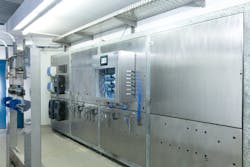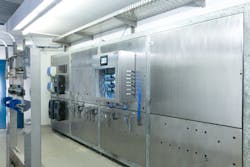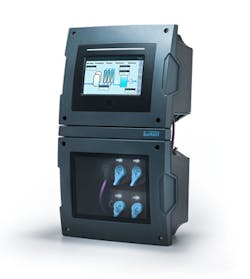A Customised Solution for Öhringen Waterworks
For the past 25 years, the city of Öhringen has continuously invested in modern water treatment facilities to guarantee a reliable and clean supply of water for its population of some 22,000. In this context, Öhringen Waterworks knew that this represented a commitment that spanned generations, and one that had to be developed for the long term in a future-proof and reliable manner - a challenge that Bürkert was happy to accept.
A modular solution with a future
A modern water analysis system must reliably evaluate water qualities from various sources, initiate control and regulation tasks, introduce early warning and alarm systems and monitor the condition of the treatment technology. Hitherto, the Öhringen Waterworks was only able to measure overall turbidity, pH value, residual ozone and chlorine dioxide content at the inlet and outlet of the waterworks and all data was transferred using analogue signals - which meant there was extensive potential for optimising the plant.
With this in mind, our customer opted for a future-proof solution, the Type 8905 Online Analysis System, in order to display reliable and continuous information about all key drinking water parameters at a glance. For the waterworks supervisor, the status of the water quality and technology is visible at all times via a display - with very low consumption of sample water.
Online analysis system in practice
In the Öhringen Waterworks, an entire wall of measuring equipment has now been replaced with a tailor-made, compact stainless steel cabinet containing a total of 14 sensor cubes and two automatic purification units to ensure reliable water analysis in a very compact space. Unlike the glass probes widely used previously, the microchips for the sensors do not require constant replacement.
This results in maintenance free and reliable operation. In total, seven different water samples with the matching individually combined sensor cubes are analysed in this system for turbidity, pH value, redox potential, conductivity and chlorine dioxide. Thanks to automatic purification units, all parts in contact with water samples can be cleaned without manual intervention.
Horst Geiger, technical director of Öhringen Waterworks, said: “This delivers clear cost savings due to fewer inspections of measurement points and lower maintenance expenditure. Staff members have more time for more important tasks.”
Good things come in small packages
The miniaturisation of sensor elements is the key innovation of the Online Analysis System. The ultra-compact sensor cubes can easily be installed in the basic module and use the EDIP - Efficient Device Integration Platform - to register their configuration and sensor specification automatically with the system.
This modular design makes it possible to retrofit new sensors easily and in any combination. Thanks to this miniaturisation, the individual sensor cubes only require very small water samples to deliver reliable results.
Geiger added: “The internal water consumption of the old system was around 15 times higher. It also required high inspection expenditure and consumed significant quantities of reagent. In this respect, the decision to procure the Bürkert analysis system as a replacement was an easy one due to the short amortisation period.”


